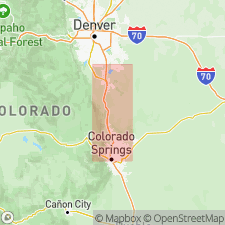
- Usage in publication:
-
- Black Squirrel Formation
- Modifications:
-
- Original reference
- Dominant lithology:
-
- Arkose
- Sandstone
- Claystone
- AAPG geologic province:
-
- Denver basin
Summary:
Pg. 10 (fig. 4), 12 (fig. 5), 28-29. Black Squirrel Formation of Denver Basin Group. Consists of sub-equal amounts of three lithologies: (1) thick and very thick-bedded, massive and cross-bedded, white, tan, and light-gray arkose and pebbly arkose; (2) thin to thick beds of light-green to olive-gray, clay-rich, fine- to medium-grained micaceous and feldspathic sandstone; and (3) thin to thick beds of dark-gray to greenish-gray sandy claystone. Thickness 500 to 600 feet. Thins to northwest where it interfingers with Pulpit Rock Formation (new) and probably with overlying Dawson Arkose (all of Denver Basin Group). Gradationally overlies and interfingers with Jimmy Camp Formation of Denver Basin Group. Fossils [listed]. Age is Paleocene.
Source: Publication.
For more information, please contact Nancy Stamm, Geologic Names Committee Secretary.
Asterisk (*) indicates published by U.S. Geological Survey authors.
"No current usage" (†) implies that a name has been abandoned or has fallen into disuse. Former usage and, if known, replacement name given in parentheses ( ).
Slash (/) indicates name conflicts with nomenclatural guidelines (CSN, 1933; ACSN, 1961, 1970; NACSN, 1983, 2005, 2021). May be explained within brackets ([ ]).

